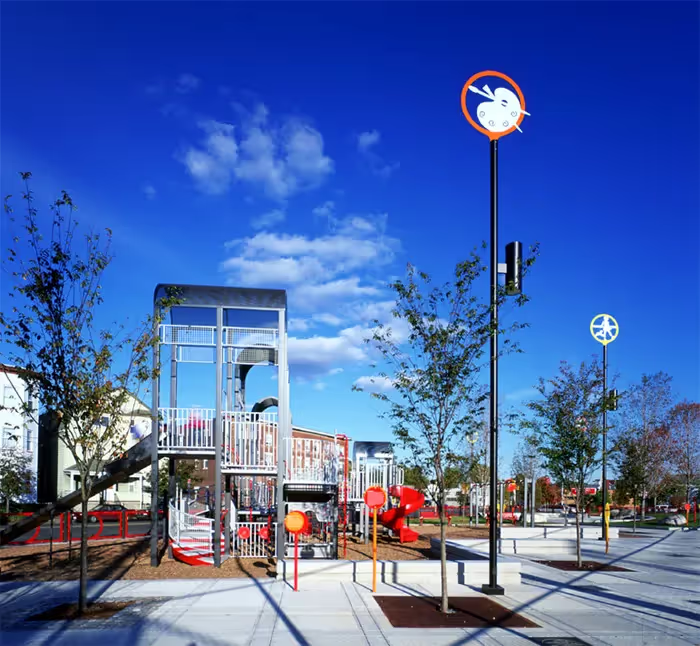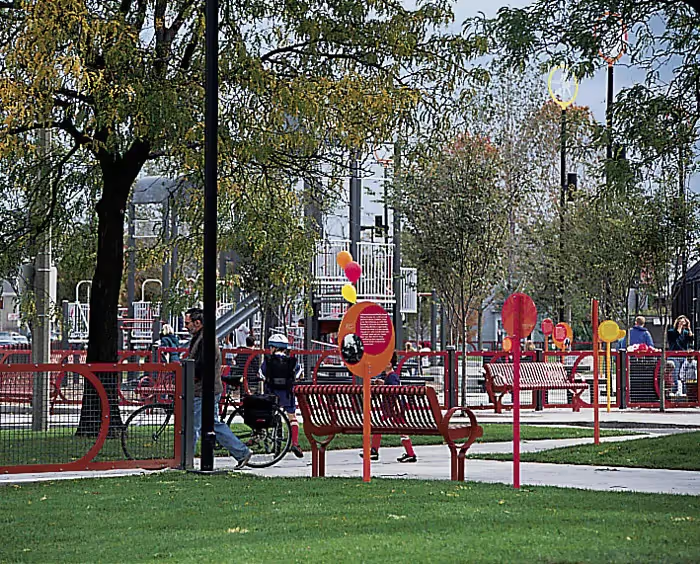A biweekly newsletter with public space news, resources, and opportunities.
A curated dispatch on all things public markets plus the latest announcements from the Market Cities Program.
Please note that these Hall of Shame nominations were written in a moment in time (most over a decade ago) and likely have since changed or even been transformed. If the above entry is now great, or still not so great, go ahead and comment below on how it has evolved or nominate it as a great place.

An urban park with multiple uses for all ages and ethnicities.

Conway Park is unique and so is the City that hosts it. Somerville's small size (4.1 square miles), and population density (18,453 residents per square mile), makes it the most densely populated city in New England. Only 3% of the city's land is open space and only half of that is stewarded by the City. Therefore our parks are precious indeed. Conway Park is a reclaimed brownfield site that was originally home to a notorious smelting company with a 50-year history of egregious environmental pollution and worker safety violations. In 1996 the City acquired the site, demolished the smelting buildings and had the toxins removed from the soil. Reclaiming this brownfield site for park use has dramatically changed the character of this working class neighborhood. It has also added an acre of open space to the original 4.6-acre Park. Strikingly transformed, the new park and its renovated portion provide many amenities that this neighborhood once lacked. It boasts the only city-owned multi-use field, new basketball and street hockey courts, swings and the "super-high" slide that all the kids at the community meetings requested, a bosque covered "caf_" picnic area which hosts family picnics and a subsidized summer lunch program, a circular plaza enclosed by a gracious seating wall and highlighted by a "pond" area with leaf prints and little bronze "critters". Soon a "Pond" Project will provide a tree identification and education program based on the trees planted throughout the park and the leaves on the "pond" bottom.
On hot summer days, people come here, talk to there neighbors and play in the water sprays. There are plenty of shady places to sit, perhaps under large newly planted sugar maples. It is envisioned that when the trees have adjusted to their new home, they will be "tapped" by school children, who will be able to turn the sap into maple syrup in the kitchen area of the new park building. The kitchen also provides the means for parents of children in the various athletic leagues to sell snacks and raise funds to buy new uniforms and equipment. The building also has restrooms and storage for park maintenance equipment. The new Park and all the amenities it brings provide City residents with new positive associations with this place. Those people who worked diligently and were dedicated to the redevelopment of this land had a vision. They saw the possibility of using the evolution of Conway Park as a metaphor for the story of many Somervillians. Park designers and community members created an outdoor museum made up of "fun" facts about Somerville's cultural history and the history of the park site and the neighborhood. It was incorporated into the Park by using text and photographic reproductions embossed on brightly painted aluminum "stop" signs throughout the park. To compliment these, a very large and intricate map of the city etched in granite welcomes new arrivals to the Park. The map is intended to connect the actual locations of historical events identified on "stop" signs to the places that they happened in the City. Cultural "icons" in the paving and "floating" on light poles above the park embellish the stories and events. The park will be an outdoor classroom too. A "rubbing" workbook, keyed to the "facts" in the Park, is planned as a teaching aid for third grade classes in the Somerville schools. This interactive workbook will connect events and places identified on the "stop" signs, paving and light poles to the granite map and then to actual places in the City. Visitors of all ages will then have a unique tool that encourages exploration by foot of the entire city using Conway Park as the hub of a spoke and wheel designed educational tool.
The park is very visible to people passing by in vehicles or on foot. It occupies over 350 linear feet on bustling Somerville Avenue, one of the three major thoroughfares in the City. The Park is one of the most accessible in town. Not only does a city bus stop at the corner of the Park, but Somerville Avenue is one of a few streets in town that has a designated bike lane. Many locals walk and ride bicycles to the park, where there are plenty bike racks for everyone. There is also a parking lot that accommodates 50 cars and a one-way horseshoe shaped drive that allows limited auto and maintenance traffic. Driving or walking by the Park, it's easy to find your way to the various activities because large circular signs with a basketball or street hockey puck indicate the various activity centers, while in the cultural history installation encourages people to explore.
The park makes a dazzling first impression. The abundance of trees in a highly urban setting, a brightly colored fence and people size "stop" signs linger all along the Somerville Avenue side of the Park. Since it was conceived of as a place for the entire City, everyone comes here. There are no gender specific activities, so an equal number of men and women, boys and girls, teens, tots and grandparents use the park every day. The seating types and choices are varied. Shaded picnic tables, low seating walls and comfortable benches can be found throughout the park and on the street adjacent to it.
For safety, and to oversee cleaning and maintenance on a daily basis, the city has assigned a very conscientious DPW employee. As a result, the community knows who to contact if a problem arises and the Park looks great!
It feels safe too, because it's well lit at night and highly visible from the street. Interestingly, though the park is visible from the street, when you're in the park, the street seems to fade away. Cars, though accommodated, are parked at the western boundary, so the vehicular impact in the park is negligible.
The park is extremely well used. Last Monday evening about 7:00 the park was hopping! There were people using every space and taking advantage of all the possibilities. Little League teams were on the field, the street hockey court and two basketball courts were full. Children and guardians who were not involved in organized activities were using the play equipment and the picnic area. The plaza became a stage for the informal games.
Conway is a great place to meet people. There are lots of places to sit and talk and the "fun" facts on the "stop" signs encourage conversations too. Some folks have parties in the picnic area and of course, extended families with children or groups of child care providers are regulars. It's a very up-beat place for many reasons but the colors and the "stop" signs add a special twist. Just walking through can make a person smile, if one is so inclined. Community members representing all the different ethnicities in Somerville frequent the playground daily (weather permitting) and neighbors bring out-of-town guests because they can have fun, relax and learn about some of the interesting people and events that make up Somerville's history. Even the Mayor often brings her grandchildren here when they're visiting.
The City of Somerville has 77,478 residents who live in close proximity to ongoing industrial and commercial uses. Our newest residents have recently arrived from Central and South America, South Asia, Africa and the Caribbean. They are crowded in with long-time residents of Irish, Italian or Portuguese descent. 23% of our population is minority. Over 50 languages are spoken; 25% of the population speaks Portuguese and 8% speaks Spanish. In 2000, the per capita income was $23,628 and over 8% of residents lived below the poverty line, with 14% of Somerville's children living in poverty. There are 114 acres of city owned open space for its 77,478 residents. Our city is an urban industrial city that borders the City of Boston. Somerville has evolved from farm country to streetcar suburb to today's densely populated urban environment. In the course of Somerville's 160 years as an incorporated municipality, more than a million people have made their home or started a business within its borders. It is this history, telling the stories of these people, often newcomers to this country, who have lived and worked in our community that provided the framework for the cultural aspect of Conway Park design. For as these immigrant families grow roots in their new country, their children and grandchildren take an increasing interest in their past. Our present Mayor is herself an immigrant, emigrating here from Ballinasloe, Ireland, 34 years ago.








*Please note that these Hall of Shame nominations were written in a moment in time (most over a decade ago) and likely have since changed or even been transformed. If the above entry is now great, or still not so great, go ahead and comment below on how it has evolved or nominate it as a great place.